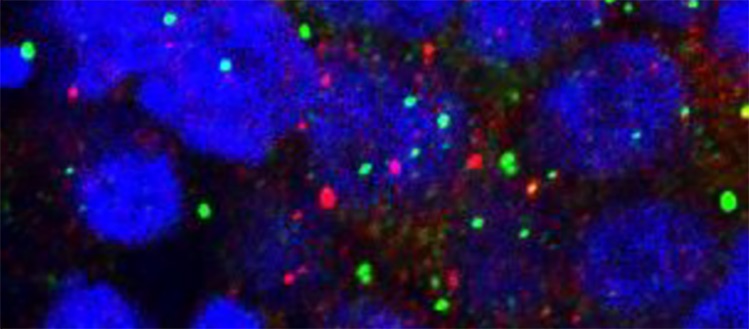A solid scaffolding for our cells
UNIGE researchers have discovered the fundamental role of the Not1 protein, which allows proteins to find each other and assemble at a precise pace, in the right place and at the right time.

Image of human cells. Not1 expression has been suppressed and the «partner» proteins do not assemble (distinct red and green dots.) © Syam Prakash Somasekharan, Vancouver Cancer Institute
To perform properly the task for which they have been synthesized, proteins must first assemble to form effective cellular “machines”. But how do they recognize their partners at the right time? Researchers at the University of Geneva (UNIGE) have deciphered the fundamental role of the Not1 protein, conserved in all eukaryotic organisms: by regulating the activity of ribosomes – the “protein factories” of our cells – Not1 allows proteins that must work together to be synthesized in the same place and at the same time. The identification of this previously unknown mechanism helps to better understand one of the most fundamental elements of cellular machinery, which, if it malfunctions, could be the cause of many diseases. Results can be read in Nature Structural & Molecular Biology.
In human cells, like in all eukaryotic organisms, the genetic material is found in the nucleus in the form of DNA. To perform the genetic programme encoded with DNA, it must first be transcribed into RNA, which in turn is translated into proteins. This job is done by the ribosomes, small machines that produce proteins by decoding RNA.
Once synthesized, the proteins arrive in the cytoplasm, between the nucleus and the membrane, where most of the cell activity takes place. However, to function properly, proteins must assemble to form cellular “machines” and perform the tasks for which they were produced. “The cytoplasm is cluttered with quantities of proteins, RNAs and organelles,” says Martine Collart, a professor at the UNIGE Faculty of Medicine, who led this work. “Let’s imagine a giant concert with a group of musicians. The room, crowded with spectators, has dozens of doors. How will the musicians, in the middle of this huge crowd, all meet in time to perform? This is what happens at every moment in the cytoplasm: proteins belonging to the same complex must find each other and assemble to function properly. ”
Not1, the multifunctional protein of cellular scaffolding
But how do proteins get there? This is where Not1 comes in: a very large protein, it acts as a scaffolding and beacon to allow proteins to be assembled according to the genetic programme they must perform. The Geneva researchers have succeeded in demonstrating that messenger RNA is associated with Not1 even before the proteins are produced. Thus, when the genetic information in the RNA begins to be read, proteins are synthesized side by side. Made nearby, they no longer have any difficulty assembling, “as if all our musicians had entered through the same door!”, underlines Martine Collart.
To confirm their hypothesis, the researchers studied a cell machinery, the proteasome, whose function is to degrade poorly formed, useless or obsolete proteins. The disruption of this important mechanism can lead to various diseases, including many neurodegenerative diseases, which are characterized by a surplus of aggregated proteins that have not been degraded. And when they prevented the expression of Not1, the scientists observed that the proteasome proteins were no longer produced side by side to assemble and accomplish their task.
Professor Collart first identified Not1 as early as 1990. “I have spent nearly 30 years trying to understand its exact role, and above all, demonstrate why Not1 is an absolutely essential element for proper cellular functioning and conserved in all eukaryotic organisms, from yeast to human beings. To prove my point, however, I had to wait for the development of a new technology, first described only nine years ago, which broadcasts “live” the translation of messenger RNA into protein.”
It’s all about rhythm
This technology – called “ribosome profiling” – makes it possible to observe the progression of protein synthesis by the ribosome. The researchers quickly realized that, far from working at a constant speed, the ribosome often takes more or less long pauses before restarting. During a pause, the portions of protein already synthesized begin to associate with their “partners”. These interruptions therefore do not seem random, but on the contrary allow proteins to assemble quickly and in an orderly manner, limiting the risk of interference. Not1 would therefore not only allow proteins to assemble, but would also regulate the working rhythm of ribosomes.
By uncovering such a fundamental cellular mechanism, this work shows that a malfunction of Not1 could be an interesting key to understanding many diseases. “In order to refine our analyses, we performed ribosome profiles on human cancer cells in parallel with healthy cells, and observed significant differences in rhythm. But how is this rhythm controlled? Would it be possible to intervene? These are some of the many questions we still have to answer,” concludes Martine Collart.
28 Jan 2019
